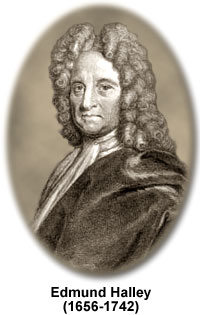Edmund Halley
(1656-1742)

Edmund Halley was an English mathematician and astronomer best known for predicting the return and calculating the orbit of the comet that now bears his name. His father was a wealthy merchant who could well afford to provide his eldest son with a good education. Halley undertook his early studies at St. Paul's School in London and demonstrated a youthful interest in astronomy that was promoted by his father, who provided him with suitable instruments. He entered Queen's College at Oxford in 1673, where he came into contact with John Flamsteed, the Astronomer Royal at the Greenwich Observatory. Encouraged by Flamsteed, Halley left school without a degree in 1676 to survey the stars in the southern hemisphere, in order to supplement the charts compiled in the northern hemisphere by Flamsteed and others.
Halley spent 18 months on the island of St. Helena in the South Atlantic, the most southern territory ruled by the British. The location made astronomical observations difficult because the island was often shrouded in clouds, but Halley persevered. Before returning to London in 1678, he had catalogued almost 350 stars and observed a variety of other phenomenon, such as the apparent decrease in brightness of some of the stellar bodies observed in antiquity. His findings, the first star charts of the southern hemisphere, were published by the end of the year. He was awarded for the achievement by election into the Royal Society and by receiving a degree from Oxford through royal mandate.
For the next two years, Halley traveled the continent before resettling in London, where he married and began a series of protracted lunar observations in an effort to correct tables of the moon's position. However, his interests were diverse and in 1684 his fascination with planetary motion brought him into contact with several of his prominent contemporaries. Robert Hooke, Christopher Wren, and Halley often conversed with each other in their attempts to determine how gravitational forces affect the orbits of the planets. Although they made some progress, Halley decided to visit Isaac Newton and was surprised to find that he had already worked out the problem and believed that planetary motion was elliptical. Extremely impressed, Halley encouraged Newton to publish his theories and even provided the financial backing for his opus, Principia.
In turn, Newton had a large effect upon the life of Halley, which later turned to the study of comets. Though they at first appeared to follow different laws of motion than the planets, Halley believed that comets must also be affected by gravitational pulls. In his analysis of comet observations, he realized that certain aspects of three (1531, 1607, and 1682) were so similar that they must be the successive returns of a single entity whose orbit was an elongated ellipse. He determined that the periodicity of the comet was approximately 76 years and in his Synopsis of the Astronomy of the Comets, published in 1705, predicted the return of the body in 1758. Though he did not live long enough to see the comet a second time, his successful prediction resulted in his name becoming permanently associated with the comet.
Halley made several other scientific contributions throughout his lifetime, although many of them are less well known. He discovered relative motion among the stars, which had previously been believed to be fixed. He contrived the first meteorological weather map and established accurate quantitative mortality tables. He also commanded the first sea voyage undertaken purely for scientific purposes, noting any compass variations that could be caused by the Earth's magnetic field. These achievements, along with his other tremendous scientific efforts, contributed to his crowning honor. In 1720, he succeeded Flamsteed, the man who had once inspired him to reach for the stars, as Astronomer Royal. Halley continued his admirable quest for knowledge at the Greenwich Observatory for his remaining years, dying at the age of eight-six on January 14, 1742.
